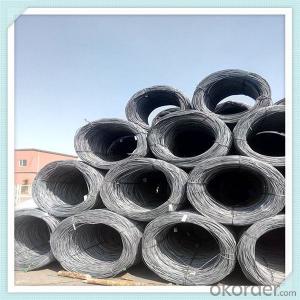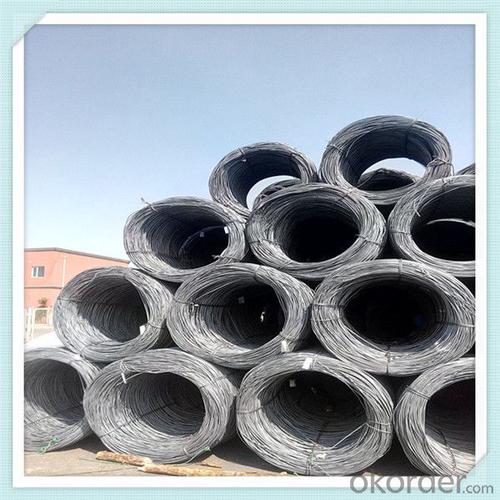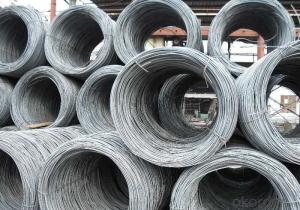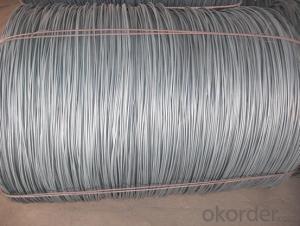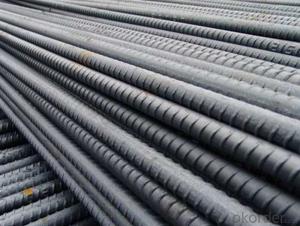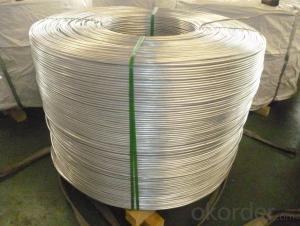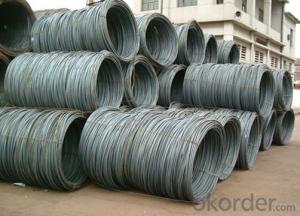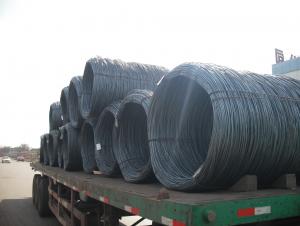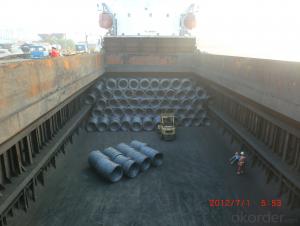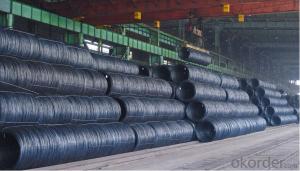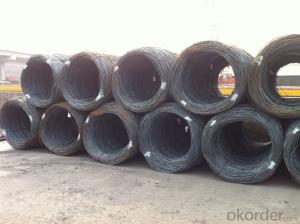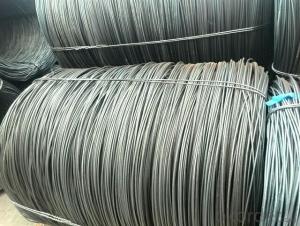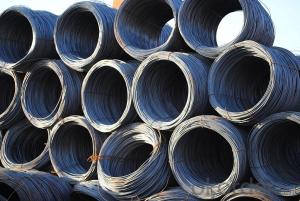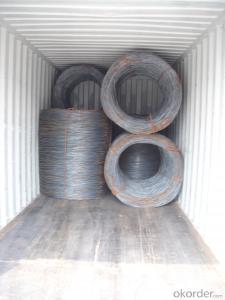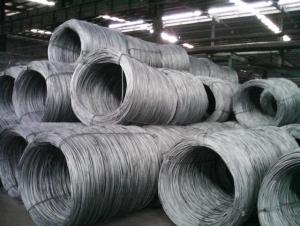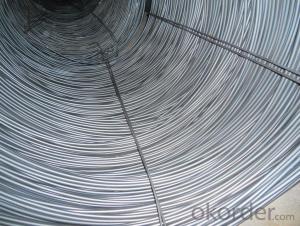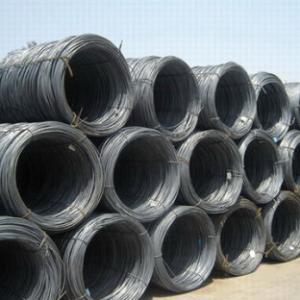Prime hot rolled steel wire rod different diameter
- Loading Port:
- Dalian
- Payment Terms:
- TT OR LC
- Min Order Qty:
- 100 m.t.
- Supply Capability:
- 16592 m.t./month
OKorder Service Pledge
OKorder Financial Service
You Might Also Like
Specification
Steel wire is mainly used for prestressed and posttensioning technology in various shapes of prestressed concrete
structures,and widely used for civil engineering construction, such as large scale railroad, highway bridges, building
trusses, overhead crane beams, industrial and prefabricated concrete floor, wall board, tubular piles, PC water pipes,
TV towers and nuclear power station, ETC. Active strandards:GB/T5223, ASTMA421, BS5896, JISG3536, ISO6934,
EN10138 or other special required standards.
Our Advantage:
High quality steel products from 1 class mills in
Reasonable price
Professionalism of the products
On-time delivery
Complete documents and certificates
Sincere service to meet our clients' requirements
Features
1、Pure steel quality, stable chemical contents, small tolerance.
2、Constant Quality, good drawing performance.
3、High dimension accuracy degree, accuracy degree of Level C up to 80%, smooth surface, less scale,
easy to be pickled.
4、Automatic bundling with 4 lines by Machine in tidy and good looks
5、Big high quality percentage, small coil percentage, and heavy coil weight for Hard Coil.
6、High sorbitizing percentage.
Product Description :
Standard | AISI, ASTM, BS, DIN, GB, JIS |
Material/steel grade | Q195-Q235,SAE1006B,SAE1006CR, SAE1008B, SAE1008CR, SAE1010B, SAE1018B, or according to customers requirements |
Wire Gauge | 5.5-12mm |
Coil weight | 1.8-2.1mts |
MOQ | 25MT |
Delivery Time | 15-30 days after receipt of L/C or deposit by T/T |
Packing | In coil and load in container, if large quantity, by bulk vessel; Can be packed as customers' special requirements |
Payment terms | 1).100% irrevocable L/C at sight. 2).30% T/T prepaid and the balance against the copy of B/L. 3).30% T/T prepaid and the balance against L/C |
Application | widely used in machinery parts, manufacturing industry, electronics industry, metal tools and others |
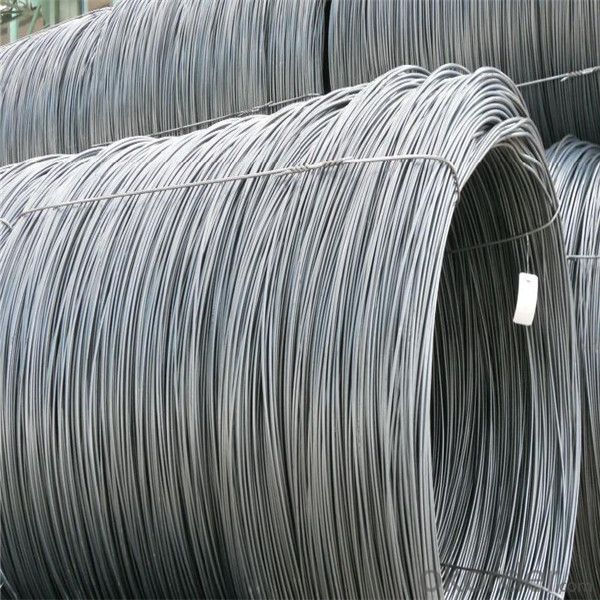
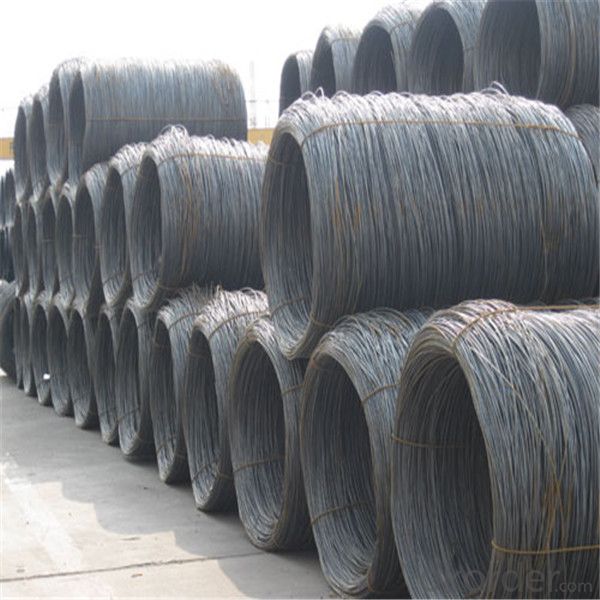
Application :
It generally used in braiding the hose for bathing product and machinery. With it
good flexibility, resistant to high temperature and resistant to corrosion, it
used widely in many industries.
Packing :
Hot-rolled wire rod is held in a unit with at least four steel straps in the
transverse direction and transported and stored without further packaging.
Before
the steel strapping is applied, the wire rod must be sufficiently compressed.
The strapping is fixed in the transverse direction with a single circumferential
strap so that the strapping does not slip and cause the coil to come apart.
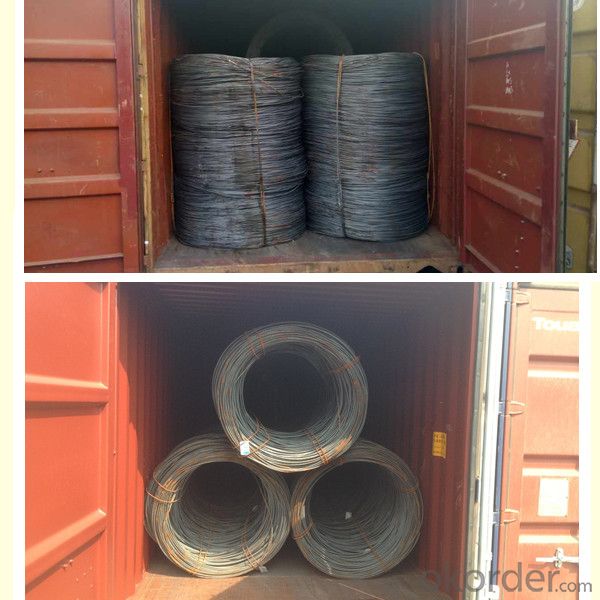

Our service:
(1) We cooperate with famous factories with advanced equipment and well trained workers.
(2) We can provide factory price with trading company service.
(3) We continuously work on the improvement of our processes, guaranteeing
consistently high standards of quality to keep none compensation.
(4) We guarantee 24 hours response and 48 hours solution providing service.
(5) We accept small order quantity before formal cooperation.
(6) We deliver the agreed quality at the agreed time, reacting to changes in
customer wishes in a flexible way.
(7) Due to our volume and selling power, we have excellent freight rates with
shipping lines.
(8) We strive to always be fair and honest in our dealings with customers.
(9) We strive to work together with customers to achieve much more than we can
achieve alone.
(10) Through our passion and commitment we aim to be a market leader in all our
key markets. To maintain our position as market leader we must continue to add
value in all that we do.
FAQ:
1.Q: What's your MOQ(minimum order quantity)?
A: One full container, mixed acceptable .
2. Q: What's your packing methods?
A: Packed in bundle or bulk ..
3. Q: How can I buy CNBM products in my country?
A:Please send us an inquiry or email ,we will reply to you if there is distributor in your country
4. Q: Can we visit your factory?
A: Warmly welcome. Once we have your schedule, we will arrange the
professional sales team to follow up your case.
5. Q: How long does it take to get the product if i place an order?
A:With the process of your requirements,we will pack and deliver in 3
-7 days. If it is by sea shipment,it will take 15-45 days depending on different locations
- Q: How is steel wire rod used in the production of wire ropes?
- Steel wire rod is the primary raw material used in the production of wire ropes. It is first drawn into a thin wire and then twisted and braided together to form the strands of the wire rope. The strength and durability of the wire rod ensure that the resulting wire rope can withstand heavy loads and provide reliable support in various applications like construction, mining, and transportation.
- Q: What are the different types of steel wire rod coatings used for increased hardness?
- There are several different types of steel wire rod coatings that are used to increase hardness. These coatings are applied to the surface of the wire rod to enhance its strength, durability, and resistance to wear. Some of the commonly used coatings include: 1. Galvanized Coating: This is one of the most widely used coatings for steel wire rods. It involves applying a layer of zinc to the surface of the rod through a hot-dip or electroplating process. The zinc coating provides excellent corrosion resistance and increases the hardness of the wire rod. 2. Zinc-Aluminum Coating: This coating is a combination of zinc and aluminum, which provides enhanced hardness and corrosion resistance. It is applied through a hot-dip process, resulting in a coating that is more durable and longer-lasting compared to a regular galvanized coating. 3. Copper Coating: Copper coatings are used to improve the hardness and electrical conductivity of the steel wire rod. This type of coating is commonly employed in applications where electrical conductivity is crucial, such as in electrical wiring and grounding applications. 4. Nickel Coating: Nickel coatings are known for their excellent hardness and resistance to corrosion. These coatings are often applied to steel wire rods used in high-stress applications where wear resistance is critical, such as in springs, cables, and fasteners. 5. Chrome Coating: Chrome coatings are used to increase the hardness and wear resistance of steel wire rods. The process involves electroplating the rod with a layer of chromium, which provides excellent resistance to abrasion and corrosion. 6. Ceramic Coating: Ceramic coatings are relatively new in the field of steel wire rod coatings. These coatings consist of ceramic particles that are applied to the surface of the wire rod using specialized techniques like plasma spraying. Ceramic coatings offer exceptional hardness, wear resistance, and thermal stability, making them suitable for demanding applications such as cutting tools and industrial machinery. It is important to note that the selection of the appropriate coating for a specific application depends on factors such as the intended use, environmental conditions, and desired performance characteristics. Consulting with a materials engineer or coating specialist would be beneficial in determining the most suitable coating for increased hardness in steel wire rods.
- Q: What are the advantages of using steel wire rod in construction?
- There are several advantages of using steel wire rod in construction. Firstly, steel wire rod has high tensile strength, making it a durable and reliable material for structural applications. It can withstand heavy loads and provide stability to the structures. Additionally, steel wire rod is highly resistant to corrosion, which ensures a longer lifespan for the construction projects. Moreover, steel wire rod is flexible and easy to work with, allowing for a variety of design possibilities. It is also cost-effective, as it requires minimal maintenance and repairs over time. Overall, the use of steel wire rod in construction offers strength, durability, versatility, and cost-effectiveness, making it a preferred choice for many construction projects.
- Q: What are the standard ductility requirements for steel wire rod?
- The standard ductility requirements for steel wire rod are typically defined by specific industry standards and specifications. These requirements may vary depending on the intended application of the wire rod. In general, ductility refers to the ability of a material to deform under tensile stress without fracturing. For steel wire rod, a certain level of ductility is essential as it allows the wire to be easily formed, bent, or stretched without breaking. The specific ductility requirements for steel wire rod are typically expressed in terms of the elongation percentage, which is determined by conducting tension tests on the material. Elongation percentage is calculated by measuring the increase in length of the wire rod after it breaks during the tension test. Common industry standards, such as those set by the American Society for Testing and Materials (ASTM), typically specify minimum elongation requirements for different grades of steel wire rod. These requirements may vary depending on factors such as the wire rod diameter, manufacturing process, and intended application. For example, ASTM A510/A510M-18a, which covers general requirements for carbon and alloy steel wire rods and coarse round wire, specifies minimum elongation values ranging from 10% to 30% depending on the wire rod diameter. Other standards, such as those set by the International Organization for Standardization (ISO) or national standards bodies, may have similar or slightly different requirements. It is important to note that specific applications may have additional requirements beyond standard ductility specifications. For instance, certain industries may require enhanced ductility to meet specific performance criteria or to ensure the wire rod can withstand severe deformation without rupturing. Overall, the standard ductility requirements for steel wire rod are determined by industry standards and specifications, which typically define minimum elongation values. These requirements ensure that the wire rod possesses the necessary deformability to meet its intended application and manufacturing processes.
- Q: How is steel wire rod used in the production of wire mesh for automotive applications?
- Steel wire rod is a crucial component in the production of wire mesh for automotive applications. It serves as the raw material that is drawn into thinner wires, which are then woven or welded together to create the wire mesh. This mesh is used in various automotive applications such as reinforcing car seats, creating protective barriers, and forming sturdy grilles. The strength and durability of steel wire rod make it an ideal choice for manufacturing wire mesh, ensuring the safety and reliability of automotive components.
- Q: What are the different types of wire drawing processes used for steel wire rod?
- There are several types of wire drawing processes used for steel wire rod, including single block, multi-block, and continuous wire drawing. In the single block wire drawing process, the wire rod is passed through a single die to reduce its diameter. In the multi-block wire drawing process, multiple dies are used in sequence to further reduce the wire diameter. Continuous wire drawing involves passing the wire rod through a series of dies in a continuous manner to achieve the desired diameter. Each of these processes offers different benefits and is used based on the specific requirements of the steel wire rod.
- Q: What are the factors that affect the quality of steel wire rod?
- The factors that affect the quality of steel wire rod include the composition of the steel, the manufacturing process, the presence of impurities, the temperature and cooling rate during production, and the quality control measures employed.
- Q: What is the average lifespan of steel wire rod?
- The average lifespan of steel wire rod can vary depending on various factors such as the quality of the steel, the environment it is exposed to, and the level of maintenance it receives. Generally, steel wire rod is designed to be durable and long-lasting. With proper care and maintenance, it can last for many years. However, if the steel wire rod is exposed to harsh conditions such as extreme temperatures, corrosive substances, or excessive stress, its lifespan may be shortened. It is also important to note that the average lifespan of steel wire rod can vary depending on its specific application. For example, steel wire rod used in construction may have a different lifespan compared to steel wire rod used in electrical wiring. Therefore, it is advisable to consult the manufacturer or industry standards for a more accurate estimate of the average lifespan of steel wire rod in a specific application.
- Q: What are the main factors affecting the price of steel wire rod?
- The main factors affecting the price of steel wire rod include the cost of raw materials, such as iron ore and scrap metal, as well as energy prices and transportation costs. Market demand and supply dynamics also play a significant role, along with global economic conditions, trade policies, and currency fluctuations. Additionally, factors like production capacity, technological advancements, and government regulations related to environmental and safety standards can impact the price of steel wire rod.
- Q: How does the price of steel wire rod fluctuate in the market?
- The price of steel wire rod fluctuates in the market due to various factors such as supply and demand dynamics, global economic conditions, changes in raw material costs, and geopolitical events. Additionally, market competition, changes in production capacity, and government policies also play a role in influencing the price fluctuations. Overall, the price of steel wire rod is subject to frequent changes in response to these multiple factors.
Send your message to us
Prime hot rolled steel wire rod different diameter
- Loading Port:
- Dalian
- Payment Terms:
- TT OR LC
- Min Order Qty:
- 100 m.t.
- Supply Capability:
- 16592 m.t./month
OKorder Service Pledge
OKorder Financial Service
Similar products
Hot products
Hot Searches
Related keywords
